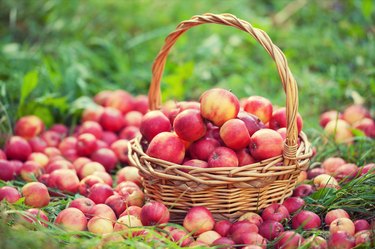
Any food or beverage that contains sugar, fat or alcohol could increase your triglycerides. Apples and bananas, natural sources of sugar, could theoretically increase your triglycerides. But unless you consume them in extremely high quantities, apples and bananas will not cause harmful increases in your triglycerides, a type of fat that can accumulate in your arteries and put you at risk for heart attacks and strokes.
American Heart Association Guidelines
Video of the Day
If you limit fat, sugar and alcohol in your diet, you can reduce your triglycerides by 20 percent, according to a scientific statement released in April 2011 by the American Heart Association. The statement, based on a review of more than 500 international studies, also noted that you could reduce your triglycerides by an additional 20 to 30 percent if you exercise regularly. The AHA guidelines call for restricting saturated fat to 16 grams a day, trans fat to 2 grams a day, calories from added sugars to about 100 to 200 a day, and fructose -- a sugar that occurs naturally in apples, bananas and other fruit -- to between 50 grams and 100 grams a day. You should also limit alcoholic beverages to one or two a day and exercise moderately at least 150 minutes per week.
Video of the Day
Fructose
A medium apple contains 95 calories and 10.75 grams of fructose. You would need to eat 10 apples a day to exceed the AHA guidelines for fructose consumption. A medium banana has 105 calories and 5.72 grams of fructose. You would need to eat nine bananas to reach the lower limit for daily fructose consumption, and 18 to exceed the maximum. The natural sugar from fruit is processed differently than fructose in added sugar, as it is not immediately available for absorption, since the digestive tract must break down the fruit cells. Unless you dip your apples in caramel sauce or roll your bananas in chocolate, you don't need to worry about bananas and apples increasing your triglycerides.
Dried and Canned Fruits
The AHA guidelines don't limit your consumption of most fresh fruits, although you should exercise caution about eating super-sweet fruits such as pineapple and watermelon. Also read product labels before buying dried fruits and canned fruits. One cup of raisins, for instance, contains 49 grams of fructose and nearly 100 grams of total sugar. If you eat canned fruit, choose varieties packed in natural juice. A cup of fruit cocktail packed in heavy syrup contains 44.4 grams of sugar. Canned apples are a better choice, with 34 grams of sugar in 1 cup, but this still amounts to three times as much sugar as in a raw apple and six times as much sugar as in a raw banana.
Fiber
Apples and bananas provide good sources of fiber, which can help reduce your low-density lipoprotein, or LDL, the "bad" cholesterol. Just as triglycerides do, LDL tends to clog your arteries. The fiber in apples and bananas may also reduce your blood pressure and blood glucose levels. A medium apple with skin provides 4.4 grams of fiber, and a medium banana provides 3.1 grams. Generally, fruit with edible skin or seeds provides healthy amounts of fiber. Other good sources of fiber are raspberries, pears, strawberries, oranges and grapefruit. Men should aim to include 38 grams of fiber in their daily diets, while women should get 25 grams.
- USDA National Nutrient Database for Standard Reference: Apples, Raw, with Skin
- USDA National Nutrient Database: Bananas, Raw
- Circulation: Heart Disease and Stroke Statistics - 2011 Update: A Scientific Statement from the American Heart Association
- Harvard School of Public Health: Fiber -- Start Roughing It!
- Harvard Medical School: Fiber Content of Foods in Common Portions
- Journal of the American Dietetic Association: Position of the American Dietetic Association: Health Implications of Dietary Fiber
- Authority Nutrition: Is Fruit Good or Bad For Your Health? The Sweet Truth